"Flexitarianism" January 7, 2010 - Volume 2 - Issue 01
|
|
|
|
|
|
Eating Differently
|
"Eat food, mostly plants, not too much." This is the tag line to Michael Pollan's book, "In Defense of 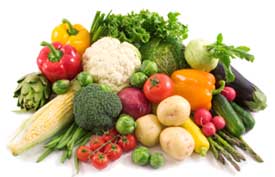 Food."
His succinct advice is not a bad one for all of us seeking new habits
in our perennial urge to start the New Year out strong and motivated in
new directions. An overwhelming number of us will make resolutions and set goals around
our diet and exercise. However, fashioning our deep desires into
action, followed by results, is a bit of a puzzle. Success is most
often realized through incremental steps - progress with one foot in
front of the other. Flexitarianism
is a newer food movement that promotes flexibility in food choices by
including more vegetarian menus on a regular basis without being
strictly meatless. It seems a sensible approach for shifting our eating
patterns to more plants. This issue focuses on a more plant-based diet
without any loss of flavor or satisfaction. We finish with three
scrumptious recipes that are all plant-based and packed with delicious
nutrition. Food."
His succinct advice is not a bad one for all of us seeking new habits
in our perennial urge to start the New Year out strong and motivated in
new directions. An overwhelming number of us will make resolutions and set goals around
our diet and exercise. However, fashioning our deep desires into
action, followed by results, is a bit of a puzzle. Success is most
often realized through incremental steps - progress with one foot in
front of the other. Flexitarianism
is a newer food movement that promotes flexibility in food choices by
including more vegetarian menus on a regular basis without being
strictly meatless. It seems a sensible approach for shifting our eating
patterns to more plants. This issue focuses on a more plant-based diet
without any loss of flavor or satisfaction. We finish with three
scrumptious recipes that are all plant-based and packed with delicious
nutrition.
|
January Product Feature
|

|
|
|
|
Flexitarianism vs. Vegetarianism
|
This fall, the Baltimore school system introduced a new tradition, "Meatless Mondays."
One day a week, their school lunch program features an all-vegetarian
menu. This is a great example of flexitarianism - an incremental
approach to introducing more plant-based meals into our diets.
 A few definitions may help to sort out all of the terms that swirl about plant-based eating choices: A few definitions may help to sort out all of the terms that swirl about plant-based eating choices:
Flexitarian
- A flexitarian is a "part-time" or "semi-vegetarian" with a greater
dependence on eating vegetables while occasionally eating meat. About
30-40% of the population describes themselves as interested in reducing
their dependence on meat. With flexitarianism, there is no strict
definition about how much meat should be eaten, just less -- it's
flexible!
Vegetarian
- A vegetarian is someone who does not eat animal meat. For most
vegetarians, this includes eliminating fowl, fish, and red meats. For
other vegetarians, they may eat fish, but not fowl or meat. Vegetarians
usually eat dairy foods, eggs, or honey, as long as the animal is not
killed in the process of producing the food. Strict vegetarians
comprise about 6% of the population.
Vegan - A vegan is a vegetarian that does not eat any animal product including dairy, eggs, honey, or any foods derived from animals.
Raw food movement
- This food trend promotes unprocessed and uncooked foods. Foods are
not cooked, nor heated above 104°F. The most common form of raw foodism
is raw veganism, though there are raw food followers that include raw
meat, unpasteurized milk, and eggs. Participants in the raw food
movement believe that cooked foods lose much of their nutritional value
and that the process of cooking may introduce harmful byproducts.
Why do people become flexitarians or vegetarians? The reasons for becoming a flexitarian or a vegetarian are varied and usually involve a combination of motives:
Health reasons
- Reduced heart disease and weight control are two prominent health
benefits of a vegetarian diet. A more plant-based diet has less
saturated fat than meat-based diets. Generally, plant-based diets are
naturally lower in calories and can create a greater sense of fullness
based on more fiber and volume.
Ecological efficiency
- Greater amounts of resource go into making meat compared to plant
foods. About 70% of the domestic grain crop goes to feeding livestock.
Per calorie, meat takes approximately ten times the amount of land and
water resource than grain and plants used directly for food.
Religious traditions
- Different religious traditions prescribe food choices based on a
variety of reasons - some on safety concerns, others as a sense of
asceticism and discipline.
Reduced carbon footprint
- Some choose less meat based on the notion that livestock feeding
operations are associated with increased methane emissions, a powerful
greenhouse gas.
Animal-friendly - Others choose a vegetarian regimen to avoid the inhumane treatment of animals.
Localvores
- Individuals that choose to eat locally, that is, within a certain
mile radius of their home, often find themselves including more
plant-based foods in their diet and less meat by virtue of its
availability.
Choosing Complete Proteins
- The body requires twenty different amino acids to form proteins that
comprise new cells, enzymes, body tissue and promote overall health.
The body can manufacture twelve of these building blocks, but must be
fed the other eight. These eight amino acids are known as the essential
amino acids. With a couple of exceptions, (soy and quinoa), individual
plants do not possess all eight amino acids as animal products do.
However, by combining different plant foods, the necessary array of
amino acids is achieved and the body is adequately nourished. The key
is to eat a variety of plant foods and combine complementary sources.  For
example, the amino acid profile in beans and grains complement each
other, dairy complements grains, and beans complement nuts and seeds.
It is not necessary to eat complementary foods at each meal, but
rather, recent research reveals that a variety of complementary foods
over a twenty-four period is just as effective. For
example, the amino acid profile in beans and grains complement each
other, dairy complements grains, and beans complement nuts and seeds.
It is not necessary to eat complementary foods at each meal, but
rather, recent research reveals that a variety of complementary foods
over a twenty-four period is just as effective.
Mainstream Meatlessness
- A vegetarian meal is no longer weird or exceptional - it's gone
mainstream. In fact, your family or guests may not even notice the lack
of meat at the table. Whatever your interest level or motive for being
more of a flexitarian, becoming comfortable planning and cooking a
vegetarian meal is easy!
|
Cooking Grains
|
Grains
are a staple of any diet and possess great nutritional value and
efficiency. As you explore flexitarian eating choices and healthy
foods, grains deserve a central role in your cooking repertoire. Not
only do they complement legumes and dairy products for a complete
protein, they provide essential vitamins and minerals in abundance. If
you're concerned about the carbohydrates in grains, know that whole
grains are complex carbohydrates and full of important dietary fiber;
keep the grains, ditch the sugar if you're worried about carbs.

Get Comfortable with Cooking Grains
- Grains come in all forms, whole, cracked, parboiled, and re-formed.
The less processed the grain, the greater the nutritional value.
Kernels should be cooked just until tender, and have a fluffy
character, without stickiness. To achieve this result, care must be
taken with (1) the ratio of water to grain, and (2) achieving a low,
even cooking temperature.
Prepping Grains for Cooking - For whole
grains and those purchased in bulk, rinse the grain in a colander prior
to cooking. This removes any dust and helps to expose any foreign
particles.
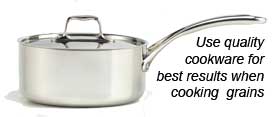
Low, Even Cooking Temperature
- The key to perfectly cooked grain is a good cooking pot and very low
simmering temperatures. A good cooking pot starts with a heavy-bottom,
sturdy conductive walls, an ergonomic handle, and a well-fitting lid.
The heavy-bottom will conduct heat evenly across the contact surface
and up the walls. A tight lid will keep the steam inside the pot doing
its work on the grain. We carry several quality lines of cookware. When
you come by the shop, we'll acquaint you with the key factors to
consider when buying good cookware.

Testing for Doneness
- Beyond these general starting points, cooking will vary depending on
the size of the grain pieces, the cooking pot, and actual temperatures.
Time the cooking so that the grain is checked only as it nears its
finish. (Too much checking will release too much steam). With a
utensil, check the bottom of the pan to assess if any grain is
sticking. Test for doneness by tasting a few grains from the top.
Ideally, the cooking water should be absorbed just as the grain reaches
the right tenderness. If the grain is cooked, but water remains, drain
the grain in a colander, return to the pan and let it sit 5-10 more
minutes with the lid on to allow any residual moisture to be absorbed.
If the water is gone, but the grain still not tender, add more water in
small increments.
 Rice Cookers
- Rice cooking appliances may be used to cook all types of grains. Rice
cookers eliminate the need for a watchful cook. The cooker quickly
heats the water and grain, reduces the power to the perfect simmer,
then automatically turns off power or shifts to a warming mode just as
the liquid is absorbed and the grains become tender. Rice Cookers
- Rice cooking appliances may be used to cook all types of grains. Rice
cookers eliminate the need for a watchful cook. The cooker quickly
heats the water and grain, reduces the power to the perfect simmer,
then automatically turns off power or shifts to a warming mode just as
the liquid is absorbed and the grains become tender.
Grains in a Slow Cooker
- Grains may be cooked in a slow cooker by using the same quantities of
grain and liquid noted above and allowing 6-8 hours of undisturbed
cooking.
|
Cooking Beans
|
 Beans
are a great source of nutrition and a good cornerstone for a
flexitarian diet. Starting with dried beans offers nutritional and
economic value, and they taste infinitely better than their canned
counterparts. Learning a few key techniques will get you comfortable
with using dried beans and reaping all of their advantages. Beans
are a great source of nutrition and a good cornerstone for a
flexitarian diet. Starting with dried beans offers nutritional and
economic value, and they taste infinitely better than their canned
counterparts. Learning a few key techniques will get you comfortable
with using dried beans and reaping all of their advantages.
 Soaking Beans
- Soaking dried beans begins the softening process and allows the beans
to cook more evenly on the stovetop. (If you use a pressure cooker to
cook beans, no soaking is necessary). Beans will triple in size as they
rehydrate, so choose a soaking pot that will accommodate this amount of
swelling; use a general ratio of 1 cup dry beans to 5 cups water.
First, rinse your dried beans in a colander and look them over to
discard any foreign particles and any discolored or shriveled beans.
Soak the beans in one of two ways: Soaking Beans
- Soaking dried beans begins the softening process and allows the beans
to cook more evenly on the stovetop. (If you use a pressure cooker to
cook beans, no soaking is necessary). Beans will triple in size as they
rehydrate, so choose a soaking pot that will accommodate this amount of
swelling; use a general ratio of 1 cup dry beans to 5 cups water.
First, rinse your dried beans in a colander and look them over to
discard any foreign particles and any discolored or shriveled beans.
Soak the beans in one of two ways:
- Hot Soaking -
Heat 10 cups of water to boiling, add two cups (1 pound) of dried beans
and boil for 2 to 3 minutes. Remove from the heat source, cover, and
let set for one to four hours.
- Overnight Soaking -
Using no heat, place two cups of dried beans in 10 cups of cold water.
Allow the beans to set overnight or for at least 8 hours.
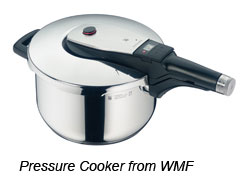 smashes easily when squished with a fork. smashes easily when squished with a fork.
Pressure Cooking Beans
- Alternatively, cook beans in a pressure cooker. It turns them into
"fast food" allowing beans to be part of everyday menus as opposed to
some periodic, heroic effort. With pressure cooking, no soaking is
required.
Beans in a Slow Cooker
- Experts recommend cooking soaked beans in a slow cooker on a high
setting for 2-3 hours taking care that they remain immersed in liquid
as they swell and absorb the moisture. After this period, turn the
beans to a low setting and allow them to cook for 6 to 8 hours. Slow
cookers are great for preparing all kinds of bean dishes.
|
Smart Flexitarian Tips
|
 Tip #1:
Cook double (or triple) batches of grains whenever cooking. Cooked
grains will refrigerate and freeze well if stored with minimal air
exposure. We find a plastic zipper bag with the air squeezed out keeps
the grain from drying out. Freeze cooked grain in logical quantities;
defrost in a microwave or steamer with the addition of a small amount
of water. Tip #1:
Cook double (or triple) batches of grains whenever cooking. Cooked
grains will refrigerate and freeze well if stored with minimal air
exposure. We find a plastic zipper bag with the air squeezed out keeps
the grain from drying out. Freeze cooked grain in logical quantities;
defrost in a microwave or steamer with the addition of a small amount
of water.
Tip #2: Keep
cans or boxes of purchased vegetable stock in the pantry for cooking
grains. Grains cooked in stock have a fantastic taste. In most cases,
the salt present in the stock is enough for the grain. If stock is
used, omit adding any additional salt.
Tip #3:
Mash cooked beans with a pastry cutter instead of a potato masher; this
helps to cut the outer skin surrounding the bean. Mashed beans can be
turned into a quick sandwich spread with a few spices and herbs.
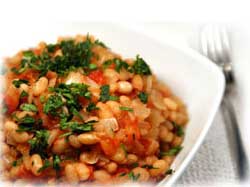 Tip #4:
Salt toughens the outer skin of beans making them less permeable to
water, and lengthening the time it takes to cook. Add salt to beans
only after they are cooked to the desired tenderness. Tip #4:
Salt toughens the outer skin of beans making them less permeable to
water, and lengthening the time it takes to cook. Add salt to beans
only after they are cooked to the desired tenderness.
Tip #5:
Refrigerate cooked beans in their liquid for up to 5 days. The liquid
will help prevent the beans from drying out. Cooked beans may be frozen
for 2 to 3 months and can be easily reheated. Boil up a big batch of
beans and package them in convenient sizes for later use.
|
Q & A's
|
 Q: What is tofu? Q: What is tofu?
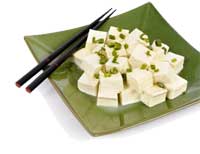 A:
Tofu is a coagulated form of soy milk. What cheese is to milk, tofu is
to soy milk. Tofu is white in color and bland in flavor. It is
nutritionally dense with a high protein, iron, and calcium content.
Like cheese, based on the amount of moisture drained from the tofu, it
can vary in texture and firmness. Tofu, while often unfamiliar to a lot
of us, is worth exploring. As a soy product, tofu provides a complete
protein source. A:
Tofu is a coagulated form of soy milk. What cheese is to milk, tofu is
to soy milk. Tofu is white in color and bland in flavor. It is
nutritionally dense with a high protein, iron, and calcium content.
Like cheese, based on the amount of moisture drained from the tofu, it
can vary in texture and firmness. Tofu, while often unfamiliar to a lot
of us, is worth exploring. As a soy product, tofu provides a complete
protein source.
Q: What is quinoa?
A:
Quinoa, (pronounced "keen'-wah," or "keen'-oh-ah"), is actually related
to beets and spinach, and not a true grass like other grains. It is
gluten-free, easily digestible, possesses a complete protein complement
and is quick cooking. Quinoa is naturally covered with a coating of
bitter saponin. This bitterness keeps it from being eaten by birds
while in the field. To remove the saponin, simply soak quinoa for a few
minutes and rinse prior to cooking. Much of the commercially available
quinoa comes pre-rinsed with the saponin already removed.
Q: If I eat as a vegetarian, will I lose weight?
A:
Maybe yes, maybe no. Many individuals adopt a plant-based diet with the
hopes of losing weight. A gram of plant-based food has less caloric
density than a gram of meat; it takes more volume of plant foods to
reach the same caloric value of meat-based foods. The additional volume
and fiber in plant food may help to satisfy appetites. Still, losing
weight comes down to calories in versus calories expended. It's
possible to gain or lose weight with any diet regimen.
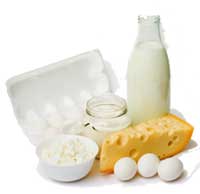 Q: What are some of the more common forms of vegetarianism? Q: What are some of the more common forms of vegetarianism?
A: Different individuals practice variations of vegetarian diets. Some of the more common adaptations include:
Lacto-vegetarian - Uses dairy products, but not eggs.
Ovo-vegetarian - Uses eggs, but not dairy products.
Lacto-ovo vegetarian - Uses both dairy and eggs.
Pescetarian - Includes fish, but no other meats.
Pollotarian - Includes poultry, eggs and dairy, but not fish or other meats.
Polpescetarian
- Includes both fish and fowl, but no red meat. Many individuals find
this regimen helpful for reducing the intake of saturated fat prevalent
in red meats.
|
|
Cookbook Review
|
How to Cook Everything Vegetarian,
Simple Meatless Recipes for Great Food by Mark Bittman. Illustrations
by Alan Witschonke. Copyright 2007. Published by Wiley Publishing,
Inc., Hoboken, NJ.
An IACP Cookbook Award Winner
Mark Bittman never tackles a subject without being thorough. We thought a previous title of his, "How to Cook Everything,"
pretty much covered everything, but Mark has created yet another
encyclopedic book covering, as promised, just about everything
vegetarian in its 996 pages. While the hefty book may be initially
intimidating, inside the subject matter is easily digestible and
presented accessibly. 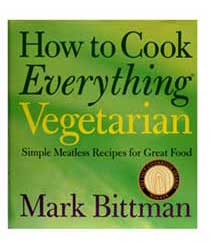 Mr.
Bittman takes an apolitical approach to the topic of vegetarianism, but
exudes an energy around the vast possibilities available in a
vegetarian or flexitarian kitchen. The cookbook begins with an enabling
introduction for approaching vegetarian cooking, then delves right into
Salads, Soups, Eggs, Dairy and Cheese, followed by Produce, Pasta,
Grains, and Legumes. He finishes with chapters on Breads of all kind,
Sauces and Condiments, and wraps up with Desserts. True to
"Bittman-style," each chapter begins with an informative context packed
with technique and basics that the recipes build upon. Generous
sidebars of information offer hints for variations, illustrated
techniques, or tips for achieving success. The book is an endless
resource of information suitable for any vegetarian or flexitarian! Mr.
Bittman takes an apolitical approach to the topic of vegetarianism, but
exudes an energy around the vast possibilities available in a
vegetarian or flexitarian kitchen. The cookbook begins with an enabling
introduction for approaching vegetarian cooking, then delves right into
Salads, Soups, Eggs, Dairy and Cheese, followed by Produce, Pasta,
Grains, and Legumes. He finishes with chapters on Breads of all kind,
Sauces and Condiments, and wraps up with Desserts. True to
"Bittman-style," each chapter begins with an informative context packed
with technique and basics that the recipes build upon. Generous
sidebars of information offer hints for variations, illustrated
techniques, or tips for achieving success. The book is an endless
resource of information suitable for any vegetarian or flexitarian!
|
|
Three "Flex" Recipes
|
Recipes excerpted from How to Cook Everything Vegetarian
by Mark Bittman. Published by Wiley Publishing, Inc., Hoboken, NJ.
Copyright 2007. Reprinted with permission of the publisher. All rights
reserved.
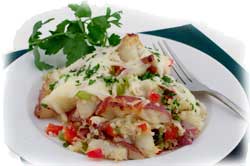 Roasted Quinoa with Potatoes and Cheese Roasted Quinoa with Potatoes and Cheese
As
promised, the cooked and roasted quinoa created a nutty flavor and
coating on the potato wedges. The inclusion of savory scallions and
peppers added just the right touch of flavor. The dish went together
quickly and tasted fantastic. It made a great main dish and a complete
meal with the addition of a mixed greens salad.
Click here to view the illustrated recipe.
Click here for a printable version of the recipe.
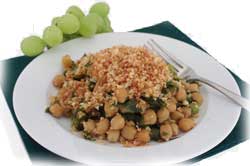 Beans and Green Beans and Green
Simple
and satisfying, this "beans and greens" dish had amazing flavor! We
cooked dried chickpeas in a pressure cooker in no time, and allowed the
greens (kale instead of broccoli raab) to become silky and tender.
Cooking dried chickpeas was much preferable to canned versions. This is
a great basic recipe for experimenting with variations of other beans
and other greens.
Click here to view the illustrated recipe.
Click here for a printable version of the recipe.
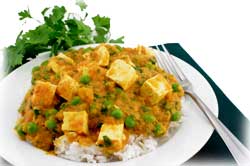 Braised Tofu and Peas in Curried Coconut Milk Braised Tofu and Peas in Curried Coconut Milk
At
the risk of stereotyping vegetarian cooking, we couldn't help but
include one tofu recipe! The Indian-inspired flavors blended together
in a great curried gravy. The tofu soaked up the piquant flavors and
along with a fragrant bed of basmati rice turned the kitchen into an
aromatic heaven.
Click here to view the illustrated recipe.
Click here for a printable version of the recipe.
|
 |
To home and hearth, to health and wealth, Best Wishes for a Happy New Year!
|
|
Lorraine, Katie, and all of the Staff at Beyond Pots and Pans
|
|
|
|
|